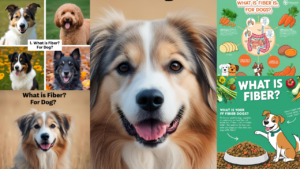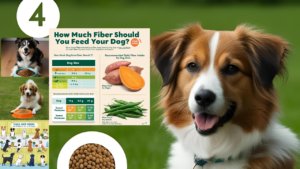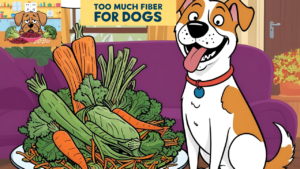1. What is Fiber?

Fiber on the other hand is a plant based carbohydrate that is not digestible by dogs. It undergoes only minimal digestion as it runs through the digestive system. Though scarce on energy value, fiber is one of the most essential nutrients to help your dog in regard to digestion.
2. Why Fiber in Dog Nutrition: Fiber is great for dogs and gives them many benefits.

There are many health benefits that can come from including fiber in the dogs diet. Here’s a breakdown of its main advantages:
A. Digestive Health
Fiber aids in maintaining the stomach and bowels of your dog. It has a bulking effect which pushes food through the gut in the proper and efficient way possible. It also aids in the prevention of constipation, and diarrhea by removing excess water within digestion tracts. Daily bowel movements are made easier and even can be established into a routine form when fiber is included in the meal.
B. Weight Management
The use of fiber in diet reduces weight gain in dogs. It makes your feel full hence your dog can take a small amount of food but will be well fed. This can be especially helpful if your dog is overweight or is prone to overeat ion both its normal meals and in between bouts of feeding. Fiber also delays digestion which means your dog will not feel hungry again soon after eating food that contains fiber.
C. Healthy Gut Microbiome
Fiber is a prebiotic stimulator, or a food that promotes the growth of friendly bacteria in the gut of your dog. Proper colon health will enhance digestion, strengthen the immune system, and enhance the wellbeing of an individual. Abundant fruits, vegetables, and whole grains create healthy bacteria that benefits the digestive tract.
3. Why Fiber in Dog Nutrition: Types of Fiber

Not all fiber is the same. There are two main types of fiber that benefit dogs:
A. Soluble Fiber
Soluble fiber swells in water so it turns into a gel like substance.Soluble and insoluble are the two classes of dietary fiber Soluble fibers soften in water and become gelatinous in texture. It delays the rate by which food is broken down and subsequently=NULL;it prevents rapid intolerance changes and also facilitates digestion of foods. These fibers are mostly consumed in foods such as oats, apples and carrots. It can be especially applied to the dogs, which have diabetes or those dogs, who are in the process of keeping their blood sugar level under control.
B. Insoluble Fiber
There are also other types of fiber, insoluble fiber that does not swell in water and is beneficial in adding bulk to stools or easing bowel movement. It is helpful for those dogs that have problems with constipation or diarrhea. Insoluble fiber is present in such foods as whole wheat, vegetables and wheat bran.
4. How much fiber should you feed your dog?

Dietary fiber is best defined in regards to the age, breed, and health of the dog as it will affect the amount that should be fed to the dog. Most adult dogs should have between 2 to 5 percent fiber in their diet on average and in total. Nonetheless, condition-wise dogs such as overweight, diabetic, or those dogs having gastrointestinal issues may possibly need more fiber.
5. Sources of Fiber for Dogs

Most of the commercial dog foods for the production of quality foods contain fiber rich materials for the digestion of the foods. Common sources of fiber include:
Sweet Potatoes: A fiber-dense vegetable that is also packed with vitamin and minerals.
Peas: These contain high amounts of fiber and have extra protein to boot.
Carrots: They are relatively very light on the systems and are highly rich in fiber, which can be taken as snack.
Apples: This is a good source of soluble fibre and vitamins and antioxidants.
By the way, if your four-legged friend receives home-cooked meals, it is necessary to add such a component as fiber. You may also speak with your vet to determine if the addition of fiber supplements is necessary and if so, what to give to your rabbit.
6. Risks of Too Much Fiber

Fiber is good, but so much of it is not good. These complications often arise where the dog has consumed excessive fiber and could be seen from gas formation, bloating and diarrhea. It can also reduce the uptake of some nutrients in the body most of which are important in body functioning. That one has to be moderate and must make sure that the fiber intake is good for their digestion trough out the day without straining their system.
7. Signs of Fiber Imbalance

Learn things that may tell you that your dog might have a deficiency in fiber or even an excess. Some of the clinical sign that could be associated with fiber deficiency include; Constipation, laziness and coat dullness. Common signs that your dog is having issues with the amount of fiber it is consuming include diarrhoea, excessive flatulence and loss of appetite.
Fiber is also very important it aids in digestion, weight control and general health of the dogs. Proper inclusion of fiber in the diet will increase the quality and activity level in your dog’s life. Feed your dog on fiber rich foods and get professional advice from the veterinary to recommend for him or her. When you feed your dog with the correct fiber it will be okay.
Can too much fiber be harmful to dogs?
Yes, excessive fiber can lead to bloating, gas, and nutrient absorption issues.
What is the best type of fiber for dogs?
A mix of soluble and insoluble fiber is ideal for balanced digestive health.
Can I give my dog human fiber supplements?
It’s best to consult a vet before giving human fiber supplements, as some may be harmful.
Is fiber beneficial for senior dogs?
Yes, fiber helps with digestion and weight control, which is important for aging dogs.
Can fiber help with my dog’s anal gland issues?
Yes, proper fiber intake can lead to firmer stools, helping express anal glands naturally.
What are some fiber-rich treats for dogs?
Healthy treats include carrots, pumpkin, and apple slices (without seeds).
Does fiber affect a dog’s energy levels?
While fiber doesn’t provide energy, it helps regulate digestion and maintain a steady metabolism.
